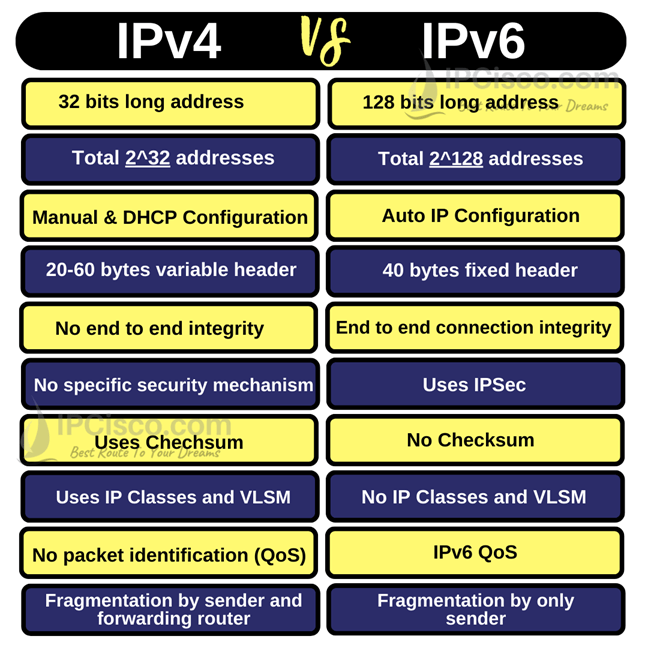Introduction to Internet Protocol (IP)
The Internet Protocol (IP) forms the backbone of the internet, allowing devices to communicate and share data. Every device connected to the internet, whether it’s a computer, smartphone, or IoT device, needs an IP address to function. Without IP addresses, it would be impossible for devices to locate each other or establish connections.
IPv4 (Internet Protocol version 4) and IPv6 (Internet Protocol version 6) are the two main versions of IP in use today. While IPv4 has been around since the early days of the internet, IPv6 is the newer protocol designed to solve IPv4’s limitations.
The Evolution of Internet Protocol
IPv4 was developed in the 1980s when the internet was in its infancy, and the number of connected devices was small. At the time, IPv4’s 32-bit address space, capable of supporting roughly 4.3 billion unique addresses, seemed more than adequate. But as the internet grew, more and more devices needed IP addresses, leading to IPv4 exhaustion.
In response, IPv6 was developed. With its 128-bit address space, IPv6 can support an almost infinite number of addresses—around 340 undecillion (that’s a 3.4 followed by 38 zeros!). IPv6 also includes improvements in speed, security, and scalability, making it better suited for the modern internet.
Overview of IPv4
IPv4 is the most widely used protocol today, responsible for assigning 32-bit addresses in a format that looks like this: 192.168.0.1. These addresses consist of four octets, each representing a number between 0 and 255. Despite IPv4’s ubiquity, its address pool has nearly been exhausted due to the surge in internet-connected devices such as smartphones, tablets, smart appliances, and IoT devices.
How IPv4 Works
IPv4 addresses are assigned in a hierarchical manner, meaning they are divided into various classes (A, B, C, D, and E) to allocate address spaces to different types of networks. IPv4 uses NAT (Network Address Translation) to extend the life of the address space, allowing private networks to use one public IP address for many devices.
However, this workaround creates challenges in routing efficiency and internet performance. A real-world example of IPv4 usage can be found in corporate networks, where an office building might have one public IPv4 address while assigning private IPs to its internal computers and servers.
Overview of IPv6
IPv6 was designed as a long-term solution to the shortcomings of IPv4, particularly its limited address space. IPv6 addresses are written in hexadecimal notation, consisting of eight groups of four characters, separated by colons, such as 2001:0db8:85a3:0000:0000:8a2e:0370:7334
How IPv6 Works
IPv6 eliminates the need for NAT, allowing every device to have its own unique public IP address. This leads to more efficient routing and faster internet speeds. IPv6 also includes built-in security protocols such as IPsec, which ensures secure communications by encrypting data and authenticating the source of IP packets.
Comparing IPv4 and IPv6

Addressing Scheme: IPv4 vs IPv6
One of the biggest differences between IPv4 and IPv6 is the addressing scheme. IPv4’s 32-bit address space allows for approximately 4.3 billion unique IP addresses, while IPv6’s 128-bit space supports an astronomical 340 undecillion addresses.
To give you an idea of the size difference, consider that while IPv4 addresses could theoretically number every grain of sand on a beach, IPv6 addresses could number every grain of sand on every beach, desert, and even on other planets!
Header Complexity
IPv6 also simplifies the structure of the IP header. In IPv4, the header includes several fields that are unnecessary for most modern networking scenarios. IPv6 reduces the number of fields in its header, resulting in faster processing times and improved efficiency.
Security Enhancements
IPv6 was built with security in mind. It comes with mandatory support for IPsec, a suite of protocols that provides data integrity, authentication, and encryption. While IPv4 can use IPsec, it’s optional and requires manual configuration, making IPv6 inherently more secure.
Real-Life Address Comparison: IPv4 vs IPv6
To better understand the scale difference, let’s compare some real-life numbers:
- IPv4: With 32 bits, IPv4 can handle 4,294,967,296 addresses. As of 2023, most of these have been allocated, leading to the use of NAT and private IP addressing to manage the shortage.
- IPv6: With 128 bits, IPv6 can handle 340,282,366,920,938,463,463,374,607,431,768,211,456 addresses. That’s enough to assign trillions of IP addresses to every human on Earth without exhausting the supply!
How to Calculate IPv4 and IPv6 Address Ranges
Calculating IPv4 Addresses
IPv4 uses 32 bits for its addresses. The total number of addresses is calculated using this formula:
232=4,294,967,296 addresses2^{32} = 4,294,967,296 \text{addresses}232=4,294,967,296 addresses
There are several websites available where you can calculate IPv4 address ranges and subnetting, such as:
- IP Calculator (https://www.ipaddressguide.com/ip)
- Subnet Online Calculator (https://www.subnet-calculator.com)
Calculating IPv6 Addresses
IPv6 uses 128 bits for its address space. The calculation is:
2128=340,282,366,920,938,463,463,374,607,431,768,211,456
To calculate IPv6 ranges and subnetting, you can use tools like:
- IPv6 Calculator (https://www.gestioip.net/cgi-bin/subnet_calculator.cgi)
- IPv6 Subnet Calculator (https://www.subnetonline.com/pages/subnet-calculators/ipv6-subnet-calculator.php)
Transitioning from IPv4 to IPv6
Dual Stack Deployment
One method used to transition from IPv4 to IPv6 is Dual Stack deployment. This allows a network to run both IPv4 and IPv6 simultaneously, ensuring backward compatibility while gradually transitioning to IPv6.
Tunneling allows IPv6 packets to be sent over an IPv4 network by encapsulating them in IPv4 packets. Common tunneling protocols include Teredo and 6to4, enabling seamless communication between IPv4 and IPv6 devices.
Security Advantages of IPv6 Over IPv4
Security is another area where IPv6 significantly outperforms IPv4. With IPsec integrated into its architecture, IPv6 offers secure connections out of the box. In contrast, IPv4 often relies on additional protocols for security, making it more vulnerable to attacks.
Real-Life Examples of IPv4 and IPv6 Use Cases
IPv4 Use Cases: Many legacy systems, corporate networks, and devices still rely on IPv4 due to existing infrastructure. For example, many small businesses use IPv4 addresses for their internal networks while connecting to the internet via a single public IPv4 address.
IPv6 Use Cases: Modern networks, particularly those focusing on the Internet of Things (IoT) and 5G, increasingly rely on IPv6. For example, smart home devices often require unique IP addresses to communicate with one another and with the internet, making IPv6 a more viable solution.
IPv6 Global Adoption
The adoption of IPv6 is steadily increasing, with countries like the United States, Germany, and India leading the charge. Many tech companies are also transitioning to IPv6 to prepare for future demands as the number of internet-connected devices continues to rise.
Future of IPv6
IPv6’s complete adoption is expected to take time, with both protocols likely coexisting for the foreseeable future. As organizations upgrade their networks and more devices come online, IPv6 will play an increasingly critical role in global internet communications.
Detailed Overview of IPv4 Address Classes
IPv4 addresses are categorized into several classes, each designated for different types of networks:
- Class A: This class is reserved for very large networks. The first octet is between 1 and 126, providing 16 million addresses per network. Class A addresses are often used by major organizations and ISPs.
- Class B: Class B is meant for medium-sized networks. The first octet ranges from 128 to 191, allowing for 65,536 addresses per network. Universities and large businesses typically use Class B addresses.
- Class C: This class is aimed at small networks, where the first octet ranges from 192 to 223. Class C can support up to 254 devices. Many small businesses and home networks utilize Class C addresses.
- Class D and Class E: Class D (224-239) is used for multicast groups, while Class E (240-255) is reserved for experimental purposes and not generally used in networking.
The Need for IPv6: Real-World Implications
The move from IPv4 to IPv6 is not just about having more addresses. It’s about the growing needs of modern internet users and devices:
- The Internet of Things (IoT): As smart devices proliferate—from home assistants to connected appliances—the need for unique IP addresses grows exponentially. Each device must communicate with others and the internet, necessitating an enormous number of IPs.
- Mobile Networks: The rise of mobile devices means that more people are accessing the internet from multiple devices simultaneously. IPv4 simply cannot support this volume without NAT, which complicates routing and slows down connections.
- Global Connectivity: IPv6 can provide unique addresses to every device globally, which enhances communication and connectivity, especially in regions where internet access is expanding rapidly.
Advantages of IPv6
While we’ve touched on the fundamental improvements of IPv6, let’s elaborate on some key benefits:
1. Scalability
With IPv6, the immense address space allows for an unlimited number of devices to be connected without requiring complex NAT configurations. This makes IPv6 inherently more scalable than IPv4.
2. Simplified Network Configuration
IPv6 includes features such as Stateless Address Autoconfiguration (SLAAC), which allows devices to generate their own IP addresses automatically when they connect to a network. This greatly simplifies network management compared to IPv4, which often requires manual configuration.
3. Enhanced Quality of Service (QoS)
IPv6 is designed to improve QoS for applications such as streaming and online gaming. It allows for better handling of data packets, prioritizing them based on the type of service required, leading to a smoother user experience.
4. Multicast Support
IPv6 supports multicast natively, which is a method of sending a packet to multiple destinations simultaneously. This is essential for applications like video conferencing and online gaming, where sending data to multiple users at once is necessary.
Challenges of Transitioning to IPv6
Despite its advantages, the transition to IPv6 is not without challenges. Here are some of the key hurdles:
1. Infrastructure Costs
Organizations must invest in new hardware and software capable of supporting IPv6. This can be a significant upfront cost, particularly for smaller businesses.
2. Compatibility Issues
Many legacy systems and applications are built around IPv4, creating potential compatibility issues during the transition phase. Organizations need to ensure that their existing infrastructure can handle both protocols.
3. Knowledge Gap
There is a knowledge gap among IT professionals regarding IPv6. Training and education are crucial for a successful transition, as many network engineers are more familiar with IPv4.
Future-Proofing with IPv6
As the internet continues to evolve, embracing IPv6 is not just an option; it’s a necessity. Here’s why:
- Growing Demand: The number of internet-connected devices is projected to reach 75 billion by 2025, further driving the need for a robust addressing system that IPv4 simply cannot provide.
- Evolving Technologies: Emerging technologies like 5G, smart cities, and autonomous vehicles require seamless connectivity and communication. IPv6 is better equipped to support the complex networks these technologies demand.
Practical Examples of IPv4 vs. IPv6 in Real Life
Let’s delve deeper into some real-world examples that illustrate the differences between IPv4 and IPv6.
Example 1: Home Networking
In a typical home network using IPv4, a router assigns private IP addresses to devices such as smartphones, tablets, and laptops. The router itself has a single public IPv4 address that connects to the internet, using NAT to manage traffic. This can lead to complications if multiple devices try to access the same service simultaneously.
In contrast, with IPv6, each device can have its own public address. This means that when you have multiple devices streaming, gaming, or downloading content, they can communicate directly with the internet, reducing latency and improving overall performance.
Example 2: Smart Cities
Many cities worldwide are implementing smart technologies to improve infrastructure and services. These smart cities use numerous IoT devices to monitor traffic, manage public transportation, and control energy usage.
With IPv4, managing these devices can become cumbersome, requiring extensive NAT configurations and limiting the number of devices that can be efficiently supported. However, IPv6 allows for direct communication between these devices and the cloud services they rely on, enabling faster data processing and improved services for citizens.
Example 3: Mobile Telecommunications
Mobile networks are rapidly moving toward IPv6 due to the sheer number of devices connecting to them. For instance, a telecom provider using IPv4 may find itself running out of address space as users connect multiple devices. By implementing IPv6, the provider can allocate unique addresses to every device, facilitating better connectivity and enhancing customer experiences.
Difference between IPv4 vs IPv6
Frequently Asked Questions (FAQs)
1. What are the main differences between IPv4 and IPv6?
IPv4 uses 32-bit addresses, allowing for about 4.3 billion unique addresses, while IPv6 uses 128-bit addresses, supporting an almost limitless number of devices (approximately 340 undecillion addresses). IPv6 also has built-in security features, better scalability, and improved routing efficiency.
2. Why is IPv6 adoption important?
As more devices connect to the internet, the demand for unique IP addresses grows. IPv6 provides a virtually unlimited address space and is essential for supporting modern technologies like IoT and 5G networks.
3. How can I check if my network supports IPv6?
You can use online tools like Test IPv6 (https://test-ipv6.com/) to check if your network is using IPv6. This website will analyze your connection and report on your IPv6 readiness.
4. Can IPv4 and IPv6 work together?
Yes, IPv4 and IPv6 can coexist in a network through various methods like dual-stack deployment, where both protocols are enabled simultaneously, allowing for gradual transition.
5. What are some challenges in transitioning from IPv4 to IPv6?
Challenges include infrastructure costs, compatibility issues with legacy systems, and a general knowledge gap regarding IPv6 among IT professionals. These hurdles can slow down the adoption of IPv6.
6. Is IPv6 safer than IPv4?
Yes, IPv6 includes mandatory security features such as IPsec, which encrypts data and ensures secure communications. While IPv4 can use IPsec, it is optional and not widely implemented.
Conclusion
The difference between IPv4 and IPv6 is a crucial topic in understanding the future of internet connectivity. With the continuous growth of internet-connected devices and the evolving landscape of technology, IPv6 emerges as a necessary upgrade to the aging IPv4 system. Embracing IPv6 will not only address current limitations but also prepare us for a future filled with endless possibilities in connectivity, security, and innovation.
As we move forward, the importance of transitioning to IPv6 cannot be overstated. By investing in this new protocol, we ensure that our networks can handle the demands of tomorrow, allowing for seamless communication between countless devices and paving the way for new advancements in technology.
follow for more tech related content www.techbulletin.in


